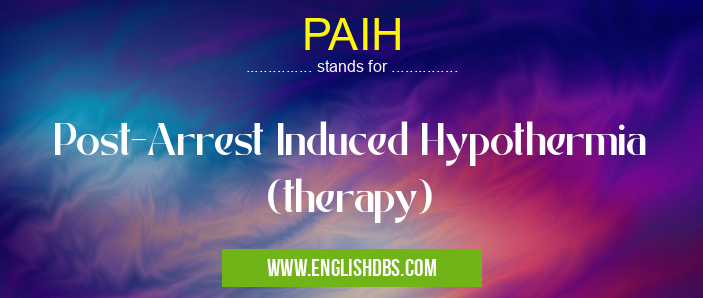What does PAIH mean in THERAPY
Post-Arrest Induced Hypothermia (PAIH) is a medical therapy used in the management of patients who have experienced cardiac arrest. It involves intentionally lowering the patient's body temperature to between 32-34 degrees Celsius (89.6-93.2 degrees Fahrenheit) to reduce the risk of brain damage and improve neurological outcomes.

PAIH meaning in Therapy in Medical
PAIH mostly used in an acronym Therapy in Category Medical that means Post-Arrest Induced Hypothermia (therapy)
Shorthand: PAIH,
Full Form: Post-Arrest Induced Hypothermia (therapy)
For more information of "Post-Arrest Induced Hypothermia (therapy)", see the section below.
Introduction: Post-Arrest Induced Hypothermia (PAIH)
Mechanism of Action
- Reduced Cerebral Metabolism: Hypothermia slows down the body's metabolic processes, including those in the brain. This reduced metabolism decreases the brain's demand for oxygen and nutrients.
- Protection Against Excitotoxicity: Hypothermia inhibits the release of neurotransmitters that can be toxic to brain cells, such as glutamate. This helps protect the brain from damage caused by excessive neuronal activity.
- Anti-inflammatory Effects: Hypothermia has anti-inflammatory properties that can reduce the inflammatory response after cardiac arrest, which can contribute to brain damage.
Indications for PAIH
PAIH is typically recommended for patients who:
- Have experienced a cardiac arrest with return of spontaneous circulation (ROSC)
- Have had a prolonged period of low blood flow to the brain (ischemia)
- Are comatose or have severely impaired neurological function after ROSC
Procedure
PAIH is typically induced using a combination of methods:
- Surface cooling: Cool packs or blankets are applied to the patient's body.
- Endovascular cooling: A catheter is inserted into the patient's blood vessel to circulate cold saline.
- Nasopharyngeal cooling: A device is inserted into the patient's nostril to cool the air they breathe.
Duration
The duration of PAIH typically ranges from 24 to 72 hours, depending on the patient's response. Once the patient's body temperature has reached the target range, it is gradually rewarmed to normal.
Benefits
Studies have shown that PAIH can significantly improve neurological outcomes in cardiac arrest survivors:
- Reduced Mortality: PAIH has been associated with reduced mortality compared to normothermic management.
- Improved Neurological Function: Patients treated with PAIH have shown better cognitive function, memory, and motor skills.
- Reduced Disability: PAIH can help reduce the risk of long-term disability and improve the quality of life for cardiac arrest survivors.
Risks
Like any medical therapy, PAIH carries some potential risks:
- Hypothermia-Related Complications: Severe hypothermia can lead to complications such as electrolyte imbalances, shivering, and ventricular arrhythmias.
- Infection: Patients under PAIH are at increased risk of infection due to suppressed immune function.
- Drug Interactions: Certain medications may interact with hypothermia, affecting their metabolism and efficacy.
Essential Questions and Answers on Post-Arrest Induced Hypothermia (therapy) in "MEDICAL»THERAPY"
What is Post-Arrest Induced Hypothermia (PAIH)?
PAIH is a therapeutic intervention where the body temperature of a patient who has suffered a cardiac arrest is intentionally lowered to between 32-34°C (90-93°F). This hypothermic state is maintained for 24-48 hours before gradually rewarming the patient. PAIH aims to protect the brain and other vital organs from damage caused by the lack of oxygen during the cardiac arrest.
Why is PAIH used?
PAIH is used to reduce the risk of neurological damage, such as cognitive impairment and coma, after a cardiac arrest. Hypothermia slows down the body's metabolism, reducing the brain's demand for oxygen and glucose, and protecting it from inflammation and cell death.
What are the benefits of PAIH?
PAIH has been shown to improve neurological outcomes in patients who survive a cardiac arrest. Studies suggest that it can reduce the risk of coma, cognitive decline, and death. It may also reduce the length of hospital stay and improve long-term neurological function.
Are there any risks associated with PAIH?
While PAIH is generally safe, it can be associated with certain risks, such as shivering (which can increase oxygen demand), arrhythmias, and electrolyte imbalances. It is important for patients to be closely monitored during PAIH to manage these potential complications.
Who is eligible for PAIH?
PAIH is typically recommended for patients who have experienced a witnessed cardiac arrest with a shockable rhythm and who have been successfully resuscitated. It is not suitable for all patients, and the decision to use PAIH is made on a case-by-case basis by the medical team.
What is the procedure for PAIH?
PAIH involves using a variety of methods to lower the patient's body temperature, such as cooling blankets, ice packs, or a cooling catheter inserted into a large blood vessel. The patient's temperature is monitored closely throughout the process. After the desired temperature is reached, it is maintained for 24-48 hours before gradually rewarming the patient.
Final Words: PAIH is a valuable therapy that can improve neurological outcomes in cardiac arrest survivors. It works by reducing cerebral metabolism, protecting against excitotoxicity, and mitigating inflammation. While PAIH carries some risks, it has been shown to significantly benefit patients who meet the appropriate criteria.
